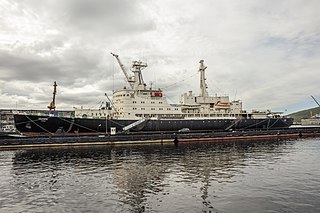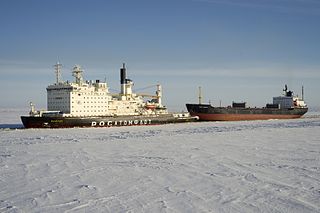Two icebreakers have been named Vaygach:
- Vaygach (1909 icebreaker) (1909–1918), a steam-powered icebreaker that sank in 1918
- Vaygach (1989 icebreaker), a nuclear-powered shallow draft icebreaker that entered service in 1990
Two icebreakers have been named Vaygach:

A nuclear-powered icebreaker is a nuclear-powered ship, purpose-built for use in waters covered with ice. The only country constructing nuclear-powered icebreakers is Russia. Nuclear-powered icebreakers have been constructed by the Soviet Union and later Russia primarily to aid shipping along the Northern Sea Route in the frozen Arctic waterways north of Siberia. Nuclear-powered icebreakers are much more powerful than their diesel-powered counterparts, and although nuclear propulsion is expensive to install and maintain, very heavy fuel demands and limitations on range, compounded with the difficulty of refueling in the Arctic region, can make diesel vessels less practical and economical overall for these ice-breaking duties.
Taymyr or Taimyr may refer to:

Lenin is a Soviet nuclear-powered icebreaker. Launched in 1957, it was both the world's first nuclear-powered surface ship and the first nuclear-powered civilian vessel. Lenin entered operation in 1959 and worked clearing sea routes for cargo ships along Russia's northern coast. From 1960 to 1965 the ship covered over 85,000 miles during the Arctic navigation season, of which almost 65,000 were through ice. Nuclear power proved to be an ideal technology for a vessel working in such a remote area as it removed the need for regular replenishment of fuel. On 10 April 1974 the vessel was awarded the Order of Lenin. It was officially decommissioned in 1989. It was subsequently converted to a museum ship and is now permanently based at Murmansk.

The Arktika class is a Russian class of nuclear-powered icebreakers. Formerly known as Project 10520 nuclear-powered icebreaker, they were the world's largest and most powerful icebreakers until the 2016 launch of the first Project 22220 icebreaker, also named Arktika. Ships of the Arktika class are owned by the federal government, but were operated by the Murmansk Shipping Company (MSCO) until 2008, when they were transferred to the fully government-owned operator Atomflot. Of the ten civilian nuclear-powered vessels built by Russia, six have been of this type. They are used for escorting merchant ships in the Arctic Ocean north of Siberia as well as for scientific and recreational expeditions to the Arctic.

Arktika is a retired nuclear-powered icebreaker of the Soviet Arktika class. In service from 1975 to 2008, she was the first surface ship to reach the North Pole, a feat achieved on August 17, 1977, during an expedition dedicated to the 60th anniversary of the October Revolution.

Taymyr is a shallow-draft nuclear-powered icebreaker, and the first of two similar vessels. She was built in 1989 for the Soviet Union in Finland, at the Helsinki Shipyard by Wärtsilä Marine, by order of the Murmansk Shipping Company. Her sister ship is Vaygach.
Seven ships of the French Navy have borne the name Astrolabe, after the instrument astrolabe

The Taymyr was an icebreaking steamer of 1200 tons built for the Russian Imperial Navy at St. Petersburg in 1909. It was named after the Taymyr Peninsula.

Icebreaker Vaygach was an icebreaking steamer of moderate size built for the Russian Imperial Navy at St. Petersburg in 1909. She was named after Vaygach Island in the Russian Arctic.

Vaygach is a shallow-draught nuclear-powered icebreaker. She was built in 1989 for the Soviet Union by Wärtsilä Marine Helsinki Shipyard in Finland by order of the Murmansk Shipping Company. Her sister ship is Taymyr.

CCGS John G. Diefenbaker is the name for a Canadian Coast Guard icebreaker that had been expected to join the fleet by 2017 but has been significantly delayed. Her namesake, John G. Diefenbaker, was Canada's 13th prime minister. It was Diefenbaker's government that founded the Canadian Coast Guard in 1962.

Apu was a Finnish state-owned steam-powered icebreaker built by Howaldtswerke in Kiel, Germany, in 1899. Initially owned by a private shipping company founded by shipowners from the Finnish city of Turku and known as Avance, she was later purchased by the Finnish Board of Navigation and her name was translated into Finnish. Apu remained in service until 1959, when she was replaced by the new diesel-electric Murtaja.

Suur Tõll is an Estonian steam-powered icebreaker preserved in the Estonian Maritime Museum in Tallinn. She was originally built for the Russian Empire in 1914 by AG Vulcan in Stettin, Germany, as Tsar Mikhail Feodorovich. In 1917, she was taken over by the Bolsheviks and renamed Volynets. However, in 1918 she was captured by Finland and served as Wäinämöinen until 1922, when she was handed over to Estonia according to the Treaty of Tartu and renamed Suur Tõll. When Estonia was occupied by the Soviet Union in 1940, the icebreaker rejoined the Soviet fleet and was again named Volynets. She remained in service until 1985.
Vaygach may refer to
Fyodor Litke may refer to one of the following icebreakers:
Two ships have been named Sibir and one has been laid with planned same name:
Two icebreakers and one class of icebreaker, have been named Taymyr, after the Taymyr Peninsula:
A number of icebreakers have been named Ilya Muromets after the Russian folk hero:
Three icebreakers have been named Georgiy Sedov: